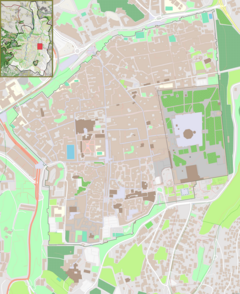Herod's Gate
This articleneeds additional citations forverification.(September 2014) |
| Herod's Gate | |
|---|---|
 Herod's Gate | |
| General information | |
| Town or city | Jerusalem |
| Coordinates | 31°46′58.8″N35°14′1.5″E/ 31.783000°N 35.233750°E |
Herod's Gate(Arabic:باب الزاهرة,Bab az-Zahra,Hebrew:שער הפרחיםTranslit.:Sha'ar HaPrakhimTranslated:Flowers Gate) is one of the seven openGates of the Old City of Jerusalem.It connects theMuslim Quarterinside of the old city to the eponymicPalestinianneighbourhood ofBab az-Zahra,situated just outside. It is a short distance to the east of theDamascus Gate.Its elevation is 755 meters above sea level.
Names
[edit]Herod's Gateis the Christian name of the gate from the 16th or 17th century.[1]InLuke 23(Luke 23:7), Jesus is sent byPontius Pilateto the tetrarchHerod Antipas,and a Christian tradition associated a somewhat-nearby house near theChurch of the Flagellationwith Herod Antipas's palace.[1] Yet another tradition claimed that the nearbyChurch of St Nicodemus(Deir al-ʿAdas) was Herod Antipas's house.[2]

Bāb az-Zāhrais the Arab Muslim name of the gate. In proximity to the gate is an Arab neighborhood calledBab az-Zahra.Az-Zahra is a corruption of the nameas-Sāhira,given to the hill andthe cemeteryacross the road, where people are buried who have performed thepilgrimagetoMecca.[3]Sura79; 6-14 of theKoranspeaks of theDay of Resurrectionusing the phrase "they shall return to the earth's surface (as-sāhira) ", and an old tradition interprets this term as the proper name of a concrete valley or plain, identified at least since the 11th century as the nearbyKidron Valley.[4]The other meaning ofsahira,taken as a verb, is "to be watchful" and would indicate how the newly resurrected would look around waiting for the events to follow.[5]The nameSahira,once corrupted to "Zahra" – sometimes rendered as "Zahara" and on maps from the late 19th-early 20th century as "Zahira(h)" – became very similar to an Arabic word for 'flower' or 'blossom',zahra.
Sha'ar HaPrakhim('Flowers Gate') is the Hebrew name of the gate. Interpreted as a translation of the ArabicBāb az-Zāhra,explained above, it would seem to be a misnomer.[6]However, the popular etymology of the Hebrew name connects it to the stone rosette which decorates the gate tower.
History
[edit]This modest gate, which opens from a wall tower, is one of the newest gates of Jerusalem. At the time whenSuleiman the Magnificentbuilt the city walls in the 1530s, a smallwicket gatewas situated in the eastern, lateral wall of the tower, which was rarely opened. Formerly, the sprawling residential area within this gate was known asBezetha(effectually translated as "New City" ), settled during the lateSecond Templeperiod to accommodate Jerusalem's growing population.[7]By 1875, in order to provide a passageway to the new neighborhoods which were beginning to develop north of the Old City, the Ottomans opened a new gate in the northern, frontal wall of the tower, which faces the Sultan Suleiman Street and offers easier access, and closed the original lateral gate.
In 1998 and during several subsequent excavation seasons (the latest in 2004), archaeologists of theIsrael Antiquities Authoritydug in the eastern area of Herod's Gate. The digging focused on three separate areas adjacent to the wall, in which nine archaeological layers were discovered – covering from theIron Ageup through the Ottoman period. Among the most significant discoveries were structures from the period of theSecond Temple,a complete segment of the Byzantine-Roman wall, and remnants of massive construction underneath the wall. These remnants were identified as portions of afortificationfrom the ancient Muslim period and from the Middle Ages.[dubious–discuss]These discoveries point out the importance which the rulers of the city gave to the fortification of one of its most sensitive places—the northern wall of Jerusalem. Indeed, historical accounts indicate that in 1099 the Crusader army underGodfrey of Bouillonentered the city through a breach located slightly east of the present Herod's Gate.[citation needed]
See also
[edit]References
[edit]- ^abMurphy-O'Connor, Jerome (2008).The Holy Land: An Oxford Archaeological Guide from Earliest Times to 1700.OUP. p. 14.ISBN978-0-19-164766-6.
[Herod's Gate] got its present name only in the C16 or C17 because pilgrims believed a Mamluk house inside near the Franciscan Monastery of the Flagellation to be the palace of Herod Antipas.
- ^Pringle, Denys (1993).The Churches of the Crusader Kingdom of Jerusalem.Vol. 3. Cambridge University Press. p. 161.ISBN978-0-521-39038-5.
... Herod Antipas and that in the Middle Ages the building was identified as the house of Herod […] However, […] there is no certain evidence to suggest that it was ever associated with the Dair al-ʿAdas before the later nineteenth century. Around that time the Dair al-ʿAdas assumed that identity from another house standing some 90 m west of it
- ^Eliyahu Wager (1988).Illustrated guide to Jerusalem.Jerusalem: The Jerusalem Publishing House. pp. 82–83.
- ^Meron Benvenisti (1998).City of Stone: The Hidden History of Jerusalem.University of California Press. p. 260.ISBN9780520207684.Retrieved29 August2015.
- ^Arthur Jeffery, ed. (1958).The Koran: Selected Suras.The George Macy Co. p. 213.ISBN9780486414256.Retrieved29 August2015.
The verb 'sahira' means "to be watchful," and there are passages in the Koran which speak of the newly risen on the Day looking around watching expectantly for what will come next. The common opinion, however, is that 'as-Sahira' here is a proper noun, the name of that wide ope plain on which men will be assembled for Judgement, in which case one should translate; "there they are at as-Sahira."
- ^Stephan Hanna Stephan,Boulos Afif and Eugene Hoade, This is Palestine: A Concise Guide to the Important Sites in Palestine, Transjordan and Syria (2nd ed.) (Jerusalem: The Modern Press, 1947), 105
- ^Josephus,De Bello Judaico(Wars of the Jews) v.iv.§ 2


